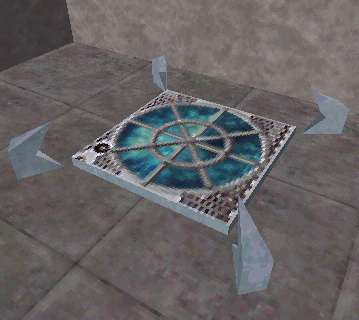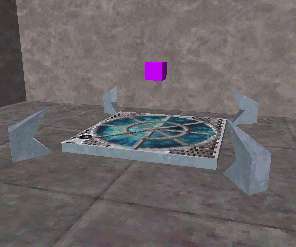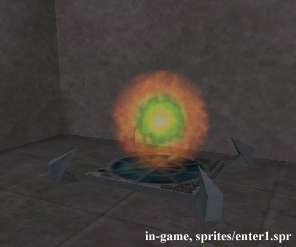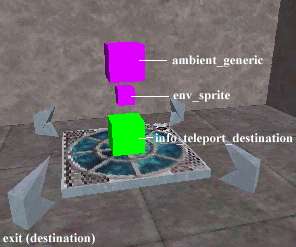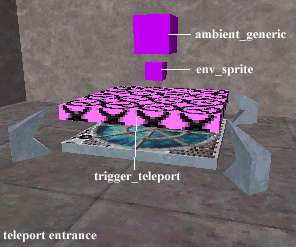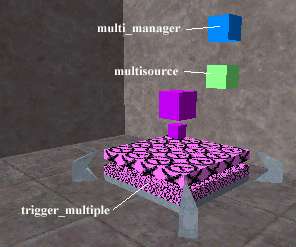VERC: Basic Teleporter with Effects Last edited 5 years ago2019-04-22 00:49:36 UTC
You are viewing an older revision of this wiki page. The current revision may be more detailed and up-to-date.
Click here to see the current revision of this page.
Basic Teleporter with Effects
Teleporters with sprite and sound effects are quite easy to construct.First thing's first, make something that looks like a teleport pad. (Well, you don't need to, but come on, it's fun). Below you can see my attempt at making the pad. The main texture there is the C3A2_TELEPAD ... fitting, no?
 The telepads in Half-Life also usually had some type of glowing sprite effect associated with them as well. We'll add that now too. Place an env_sprite a little above the telepad. For reference, in the example map there are 28 units between the top of the telepad and the center of the env_sprite. Below are the properties you'll need to set (those not mentioned can be left at their default).
The telepads in Half-Life also usually had some type of glowing sprite effect associated with them as well. We'll add that now too. Place an env_sprite a little above the telepad. For reference, in the example map there are 28 units between the top of the telepad and the center of the env_sprite. Below are the properties you'll need to set (those not mentioned can be left at their default).
- Render Mode (rendermode) - This should be set to Additive (5).
- FX Amount (renderamt) - This should be set to about 100. Higher, and the sprite will appear more solid; lower, less solid.
- Sprite Name (model) - I might be picky, but I like to use sprites/enter1.spr for the teleporter, and sprites/exit1.spr for the destination telepad.
- Scale (scale) - This is purely a matter of preference, but I think these sprites look best with a scale of 0.75.
- In the Flags properties, the Start On (1) flag should be set.
- Name (targetname) - Set this to tele1_sound for both ambient_generic entities. They'll both be played at the same time.
- Path/filename.wav of WAV (message) - Again, the sound your teleporter makes is a matter of preference. I like to use debris/beamstart1.wav
- In the Flags properties, the Medium Radius (4), Start Silent (16), and Is NOT Looped (32) flags should be set.
Place the info_teleport_destination entity over the destination telepad. Set its angle to the direction you want the player to be facing after he teleports. Set the Name (targetname) to tele1_dest. That's the destination done with.Now, for the teleporter. Create a trigger_teleport brush directly over the telepad. Set its Target (target) to tele1_dest. For now, this is all you need to do, if you want to test that it works. If you compile and run this now, you will be able to walk into the teleporter and come out at the destination. However, the sounds won't be played. We'll cover this next.First, create a multisource entity somewhere close to the trigger_teleport brush. In the multisource properties, set the Name (targetname) to tele1_master. Now, in the trigger_teleport properties, set the Master (master) to tele1_master. This will make the trigger_teleport active only when the multisource state is on (it starts off by default).
If you tested the map now, nothing would work, because there isn't any way for the multisource to be turned on. To remedy this, create a multi_manager near the multisource. Give it a Name (targetname) of tele1_mm, then turn off SmartEdit and give it the following keys and values.
- tele1_sound with a value of 0
- tele1_master with a value of 0
- tele1_master with a value of 0.01 (will show up as tele1_master#1)
So, to wrap it up, the events will occur as follows-
- player walks into the trigger_multiple trigger area
- the trigger_multiple activates the multi_manager
- the multi_manager:
- activates the ambient_generic entities, playing the teleport sounds
- activates the multisource, enabling the trigger_teleport which teleports the player to the info_teleport_destination
- activates the multisource again, disabling the trigger_teleport
- the player is left at the teleport destination
Example Map
- Categories
- Archived Articles
- VERC Archive
- VERC - Half-Life
- VERC - mapping
- Tutorials
- Mapping
- Requires Examples
1 Comment
Anderson
Commented 5 years ago2019-08-30 23:43:48 UTC
Comment #102235
Thanks! Used this for my in-progress DarkRP map rp_downtown_thepublic.
You must log in to post a comment. You can login or register a new account.

